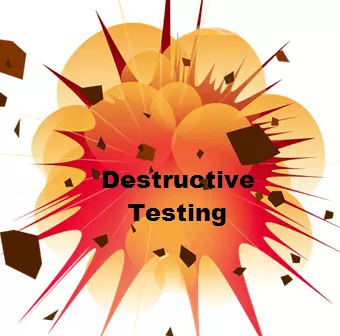Destructive Testing is defined as a type of software testing to find fault points in a software program. This is a test method in which an application is intentionally executed to test the robustness of the application and determine the point of failure.
Unlike other test methods, this app’s functional test technique tests the user’s unpredictable behavior towards that application.
For Destructive Testing, it is not necessary to have knowledge of the initial requirements of a software product. However, some knowledge can help the test strategy run and get better results.

Why Destructive Testing?
- Helps understand predictable software responses when software is used incorrectly
- It helps test the robustness of a software.
What should you check during Destructive Testing?
In Destructive Testing you will check the following
- Response of the appropriate software
- The software’s response is inconsistent
- Improper use
- Input data is not matched
- Data output match
How to Perform Destructive Testing
Destructive Testing involves many activities such as designing a set of test scripts, executing test scripts, correcting errors, closing errors and providing pass or fail metrics to stakeholders at the end of the iteration.
For Destructive Testing, there are many ways to test. Let’s see some examples-
- Failure score analysis method: This is a system guide that evaluates what could go wrong at different points. For this strategy, help from BA (Business Analyst) may be required.
- Testers peer review: Your test cases analyzed or reviewed by another tester colleague who is less familiar with the system / functionality
- Business evaluation of test cases: End users or experts may come up with many valid scenarios that sometimes testers may not consider or ignore as their whole focus will be on testing the requirements.
- Conduct exploratory testing, using run sheets: Performing Exploratory testing using run sheets, will help identify what has been tested, repeat tests, and allow you to control the scope of your testing.
- Using another source: You can ask someone to poke around a software product and analyze different scenarios.
Destructive Testing Method
Following are the different Destructive Testing Methods used in Software Engineering:
- Alpha / Beta Testing
- Regression Testing
- Interface Testing
- Equivalence Partitioning
- Loop Testing
- Acceptance Testing, …
Destructive Testing
Below are the Destructive Testing Techniques that can be used:
- White Box Testing
- Security Testing
- Defect Testing
- Smoke Testing, …
During Destructive Testingy there are certain test conditions
- The software will never process or accept invalid input
- Regardless of whether the input data is valid or not, the software must always produce the appropriate output
Summary:
In this technique, an application is intentionally created so that the program cannot check its robustness. For Destructive Testing, it is not necessary to have knowledge of the initial requirements of a software product.
The article is translated from source: https://www.guru99.com/
